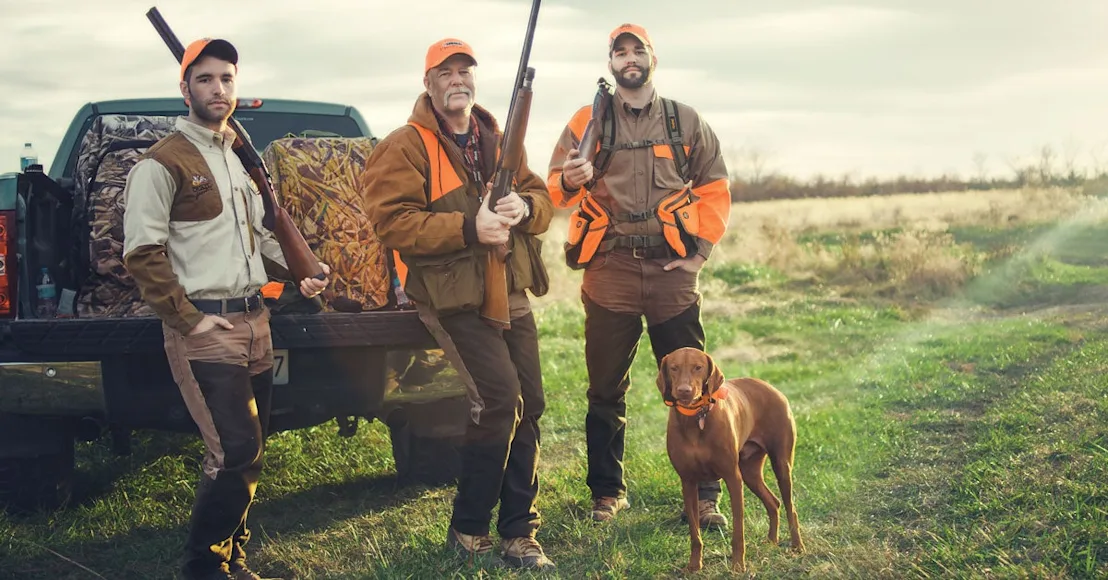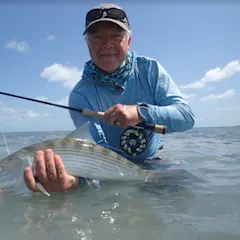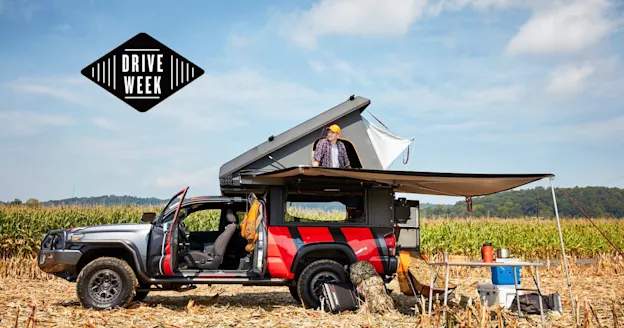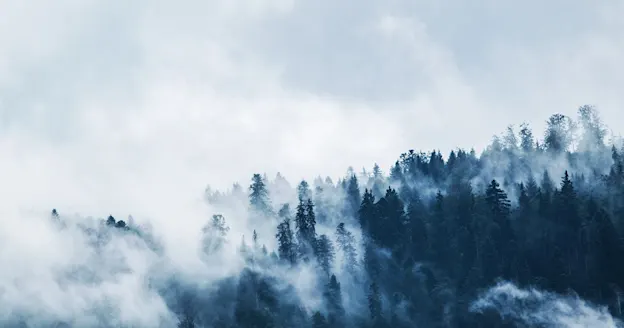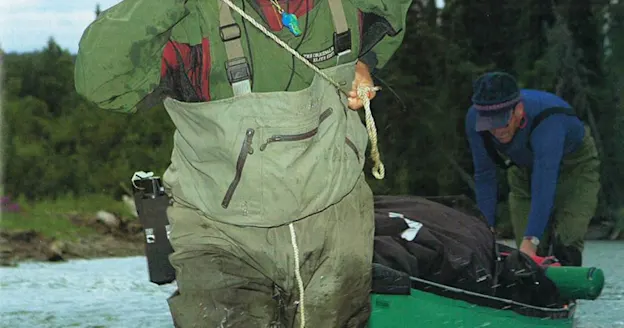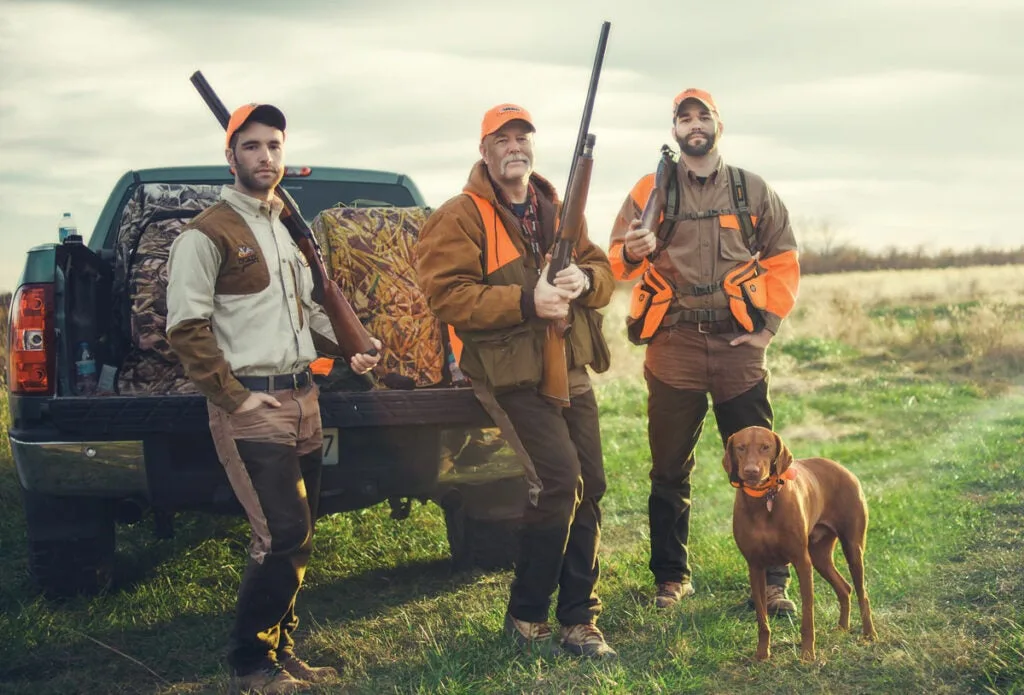
Bill White and his sons Tony (left) and Andrew at a quail-restoration site in northwest Missouri. Photographs by Michael Sugrue
Bill White makes me question everything I’ve heard about wild bobwhite quail hunting for the past 20 years: The land has changed too much for coveys to thrive. What the hawks don’t eat, the coyotes will. There are no birds left. There’s no way to turn back time. Sportsmen seem to have long ago agreed that, while you can hunt bobwhites as a curiosity and keep a bird dog as a memento of yesteryear, wild quail hunting as a popular pursuit is on its last tired legs.
At the moment, however, Bill is up to his eyeballs in foxtail and Indian grass as he crashes through a Missouri oak savanna. His sons Andrew and Tony trail 40 yards behind him and me, working through tangles of honey locust and Osage orange. We’re all hustling to keep up with Chief, a German wirehair, and Jake, a Hungarian vizsla, both with snouts full of partridge pea and bobwhite quail. Trapper, a GSP, is 80 yards away in short oaks. He’s on birds, too, but a stiff wind has the quail unnerved. They don’t like the noise and the confusion—and they’re on the run. Trapper and I try to head them off.
Though many bird hunters these days rely on pen-raised quail, the Whites and I are chasing 100 percent wild birds—which act like it, too. Before we can converge on the covey, the birds blow out 30 yards in front of Trapper, roaring from the brush and scattering. But a bird makes a break from the commotion, and then the rest comes naturally: My barrel swings, the muzzle blots the quail, and the trigger pulls as if by its own accord. The bobwhite crumples into a sumac thicket, and Trapper vaults for the retrieve. It’s a frantic, thrilling scene that makes me wonder if Bill and his family can, in fact, turn back time for wild bobwhite hunting.
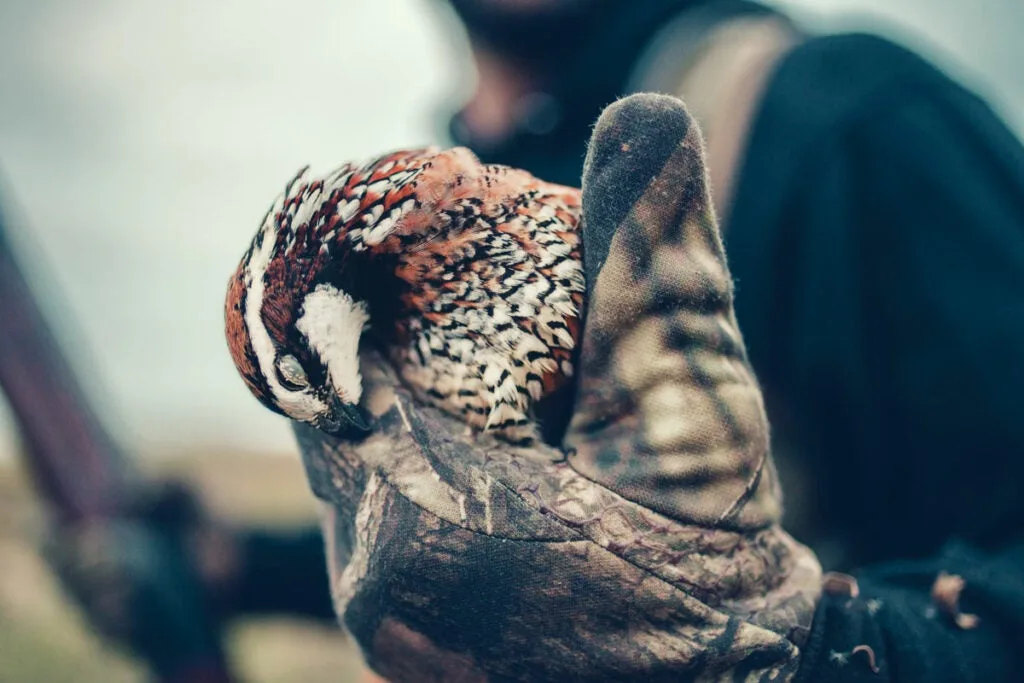
Rare BirdsLong a fixture of sporting heritage, the northern bobwhite traditionally ranged across the Midwest and the eastern U.S. For generations, many hunters got their start behind a bird dog, paired with a father, an uncle, or a family friend, on a farm with unkempt hedgerows and ditch banks. Over the past 45 years, however, bobwhite quail numbers have fallen as much as 80 percent nationwide, and as the population has tanked, so has the number of quail hunters. In Missouri, in particular, where Bill lives, approximately 186,000 wingshooters took to the fields for quail in the late 1960s. At last count, in 2013, there were fewer than 16,000, according to the Missouri Department of Conservation (MDC). Likewise, in neighboring Oklahoma, the Wildlife Management Institute notes that the number of quail hunters plummeted from 110,000 in 1980 to only 30,000 by 2013.
Still, bobwhite hunting flourishes in some places. Robust bird populations inhabit large Southern hunting plantations, for example, though a lot of these spreads are money-fueled productions that spend hundreds of thousands of dollars or more on quail management each year. The future of wild quail hunting—for everyday hunters—depends on scientists and sportsmen who are reimagining public bobwhite-habitat management by turning large swaths of land into quail-friendly farms. And it depends on people who refuse to give up on wild bobwhites. People like Bill White.
The Whites are Missouri’s first family of quail—equal parts prophets and foot soldiers in a new era of bobwhite restoration. Bill is a wildlife biologist for the MDC, with nearly 30 years of experience as an upland-bird specialist. Likewise, his son Andrew, 27, is a biologist for Quail Forever and Pheasants Forever; and Bill’s youngest, Tony, 24, founded the nation’s second collegiate chapter of Pheasants Forever, in 2013, and now keeps a bird dog with him while he’s away at medical school.
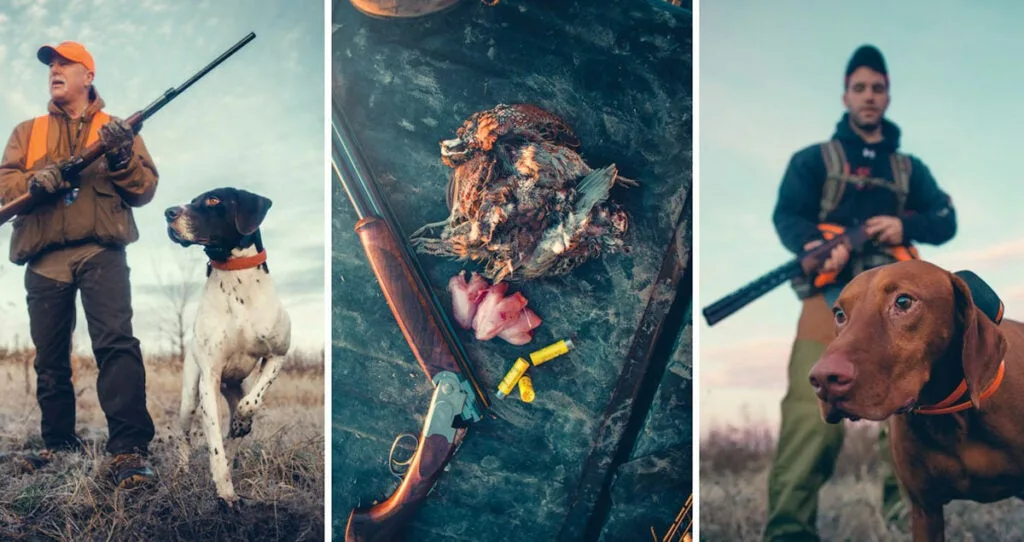
Bill White and Trapper, a GSP; a truck-bed butchering block; Jake, a vizsla.
I meet the Whites outside Chillicothe, Mo. My plan is to spend a few days with them—to chase quail and learn about their efforts to save Mr. Bob—but my first morning with them already offers proof that quail hunting may have a future. Not long after legal light, a covey bolts in front of the dogs and breaks into two groups 50 yards from the truck. One soars into a tangled draw, and the other settles into oaks along a slope of old field grasses. The wind is steady at 20 mph, rocking the foxtail and giant ragweed like waves at sea. Quail get anxious in these conditions, unable to easily spot predators, and they’re unlikely to hold tight for a bird dog. For the next hour, the hunt is as much a footrace as a gentlemanly pursuit. Bill barrels through stands of saplings, encouraging the dogs to continue through the tough country. When Chief, the big wirehair, is on birds, I can hear him inhale great sucking breaths, as if he’s trying to draw in the birds, the dirt, and the weeds, and sort them out in his brain. Soon he goes on point, but when we move in, we find only a pile of quail droppings—a roost from the night prior. We push the dogs onward.
The three Whites settle into what must be a family ritual: Andrew and Tony bring up the rear, keeping their eyes on the dogs, while Bill is, as always, out front or off to the side, crashing through the nastiest brush. He is rangy, with a reddish-gray horseshoe mustache, and has a patriarchal mien. In many ways, his feet are firmly planted in both the past and the future of bobwhite quail: As a kid, he hunted the birds by running a flushing Lab along fencerows and woody ditches. As an adult, he’s watched highly efficient clean farms and exotic grasses, such as fescue and brome, replace those same unkempt fields. “We could see it happening across Missouri, the Midwest, and the South,” Bill says. “But the forces were at such a large scale, across entire landscapes, that they seemed impossible to counter.”
Bill has spent most of his adult life focused on bobwhites, trying to understand the basic mechanics that have driven quail populations to lows he couldn’t have imagined as a kid. Early in his career, while working on the state level to stem the losses, he wondered if he could personally help the quail recover in some small way. So, in 1989, he bought a 60-acre farm an hour west of Chillicothe, and he and his family threw themselves into managing the land for birds.
On the farm, the Whites began employing practices that have inspired Missouri’s renewed quail-restoration efforts. To give the birds protective cover between thickets and fields, where they’re often preyed upon, the Whites toppled trees along field edges and let the hedgerows grow thick. To provide open areas for feeding, they killed invading fescue and brome, and they reset the vegetation to early growth, which upland birds require, with prescribed burns. Likewise, long before today’s honeybee crisis, the family planted native prairie wildflowers and rotated fields of millet and milo to bring pollinators to the farm.
Andrew and Tony were kids when the work first started, and those early years on the farm shaped them as much as they shaped the land. While their friends played baseball or lounged indoors, the brothers hand-pulled thistles, plowed firebreaks, and seeded blackberry shrubs with shovels. Tony recalls a time when Bill invited a friend and his son to come quail hunting, but his buddy’s kid wouldn’t come along because he wanted to stay home and play video games. “I remember that morning,” Tony tells me. “Dad came home and said, ‘You don’t want to be like that. You’re not going to be like that.’ That really stuck with me.”
The way wildlife reacted to the family’s homegrown efforts left an impression on the Whites, as well. When Bill bought the property, it supported two bobwhite coveys at most, but it didn’t stay that way for long. “Every time we’d try something new, the quail would respond,” Bill says. In the mornings, the family began hearing quail and pheasant calls through the open windows. Neighbors also began managing their property for quail, leveraging the Whites’ efforts, and after a decade of hard work, between 10 and 12 wild coveys had settled on the family farm. “We were doing the right things without knowing what the right things were,” Bill says about the family’s holistic approach.
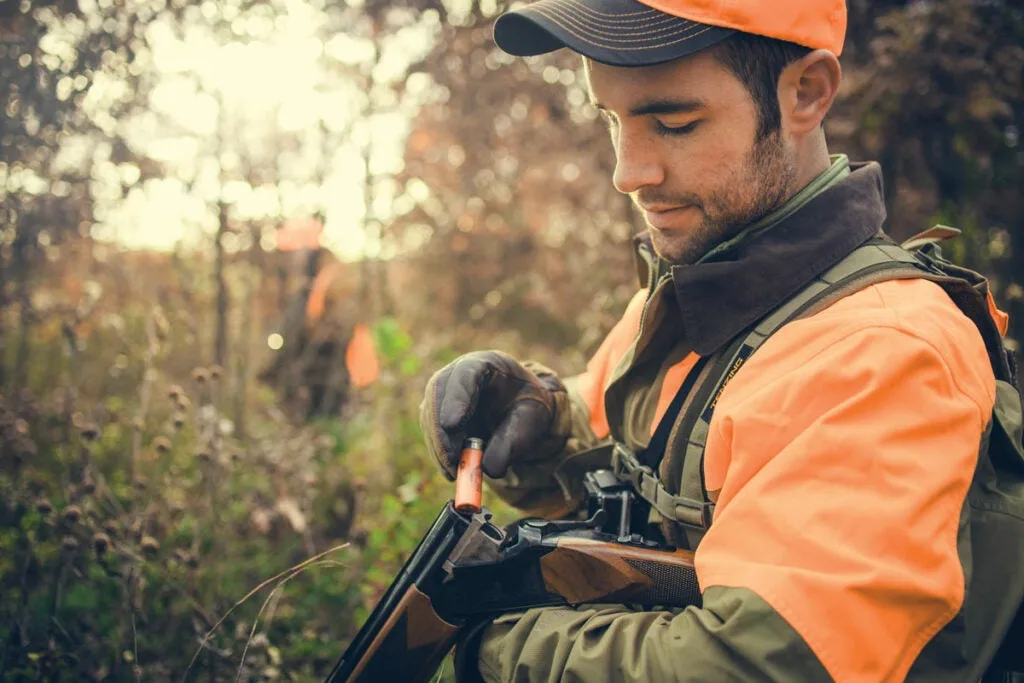
Soon, though, Bill recognized that he could make only so much progress on a single farm. “We saw the value of connectivity, and how good habitat would suck in birds,” he says. “It helped us understand that this was a job you can’t piecemeal out. It takes larger landscapes.” So, in 2001, Bill brought his hard-won, small-farm lessons to his colleagues at the MDC, which, in 2005, launched a quail research-and-restoration plan on public and private lands with techniques the Whites had honed on their 60-acre spread. The department, embracing quail restoration with a fervor hardly matched in the country, now intensively manages quail habitat at 19 public-land focus areas and employs a staff of more than 50 biologists, whose sole mission is to help private landowners tap into the increasing amount of quail-management resources.
The results have garnered the attention of quail biologists and hunters across the Midwest. On average, quail counts at Missouri’s focus areas report three to five times more bobwhites than at adjacent plots, and it’s common for dogs to point a couple of coveys in an hour of hunting these lands. “From the 1990s on, everyone from biologists to hunters to landowners was giving up on quail,” Bill says. “Over the last few years, we’ve turned the corner. We now know what it takes to bring them back.”
Those words come to life when, as we push through the tall brush, things suddenly get squirrelly. Bill misses twice on a busted covey, and Trapper, the German shorthair, tunnels forward, convinced there’s a dead bird somewhere. While in the thicket, he goes on point again, and Chief honors his hunting partner. When the covey breaks, I track three birds—but I’d be lying if I told you I was certain that the bird I shot at and the bird that fell were the same. Next, we turn the dogs toward the oak savanna that holds one of the original quail groups, but halfway up the hill, Trapper turns to stone on a different covey. Behind us, quail whistle from a field sown with native grass—covey No. 3. Then, from beyond a tree grove, Andrew shouts: “Got a point down here!” For a moment, the four of us can head forward, backward, or toward the horizon, none of which are poor choices.
Bill looks back at me and smiles. “Birds all around us,” he says. “This is what it can be.”
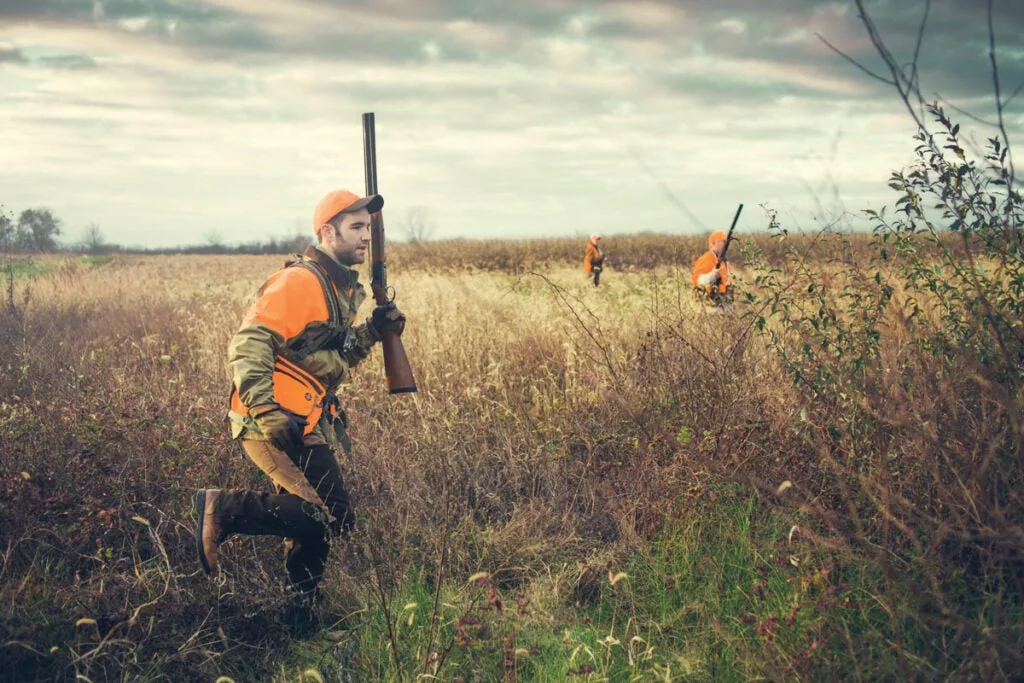
One Last PointOur second morning suggests a more civilized hunt than yesterday’s. The wind has softened, and frost in the fields sparkles under the truck’s headlights. We listen for covey calls, a low-pitched whistle, which the birds don’t make for long—a minute, maybe two at most. I strain to make out the sounds, and I hear one call, but just barely. Andrew hears four coveys, each from a different direction. “It’s all lined up for us this morning,” he says. “Let’s get the dogs on the ground.”
It’s hard to wrap my head around what happens next. We hunt hard for four hours, following the dogs through cover both thick and thin, but we never come up with a point. We know the birds are here. We heard them in the dark. But exactly 24 hours after yesterday’s quail frenzy, the dogs are batting zero. I take solace in the fact that though the conditions for hunting are perfect, the conditions for quail to stay hidden on this carefully managed farm are spot-on, too.
This morning’s hunt illuminates one of the main challenges facing quail managers today: keeping hunters interested in chasing birds that aren’t easy to find, even on perfect days. Tony White himself is emblematic of the problems that face the sport. Though Tony shares his dad’s love for science, the unsettled nature of wildlife-science funding pushed him toward medicine, rather than conservation, as a career. Likewise, he remains less hopeful than his dad and his brother that the number of bird hunters will stay strong—at least among his peers. For starters, he figures that bird hunting requires bird dogs, which demand commitment and time that a lot of young hunters can’t afford. Also, two years ago, when he and a few other serious bird chasers started the Pheasants Forever and Quail Forever chapter at the University of Nebraska, the effort was gangbusters in the beginning, raising $8,000 at their first banquet. But the energy ebbed as the founders graduated and moved on. “I have a dog and access to land so it’s easier for me,” Tony says. “But it’s hard to get into quail hunting if you’re starting from scratch. Organizations such as Pheasants Forever and Quail Forever will pull the shirts off their backs to help you get going, but it’s still a serious commitment.”
The rise in popularity of other hunting pursuits poses a threat, as well. “Deer and turkeys are relatively easy to manage for,” Bill says. “Their high numbers are a by-product of what we’re already doing with the land. But you have to work for quail. You can’t just plant stuff and walk away.”
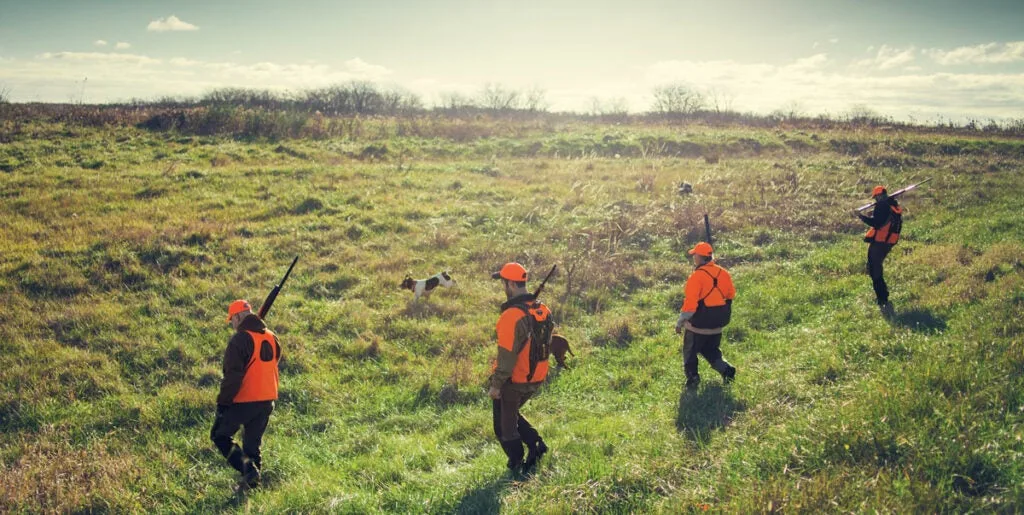
The sun is high as we press on through fields studded with sumac, the morning frost long faded, and pass treetops sheared by chain saws, offering cover for quail along the edges of cut rows of soybeans. In some ways, it’s a landscape from another time—patchy, weedy, tangled—but it’s a modern creation nonetheless, a matrix of the cultivated and the wild, proactively planted and managed, a coming together of science for the future of wild quail, if there is one.
For a moment, I stop and look at the hills, rolling in every direction. Small tracts of wheat and sunflower checker the ridge, giving way to lower slopes of overgrown fields and a gully choked with shrubs. The scene would make a modern farmer’s skin crawl, but Bill couldn’t be happier with it. “This is what I grew up with,” he says. Then, as if on cue, Chief locks up in a nearby copse of white oak. Trapper quivers on point in front of him. Andrew and Tony wade from behind through chest-high brambles, trying to lead Jake to the scene before the birds get too nervous to hold.
Bill half turns to look over his shoulder, ensuring his sons recognize what’s happening, then he hustles them up to the dogs. “Here we go, boys!” he calls. For a moment, I’m unsure if he’s talking to the boys or to the dogs. But it doesn’t matter, because they’re all here, three Whites and three gun dogs, all closing in and coming together, like they’ve done for most of their lives, trying to figure out what the birds will do next.

